Response Study of Streamflow and Sediment Reduction in the Northeast Region of the Loess Plateau under Changing Environment
Abstract
1. Introduction
2. Materials and Methods
2.1. Study Area
2.2. Data
2.3. Methods
2.3.1. Soil and Water Assessment Tool (SWAT)
2.3.2. Integrated Valuation of Ecosystem Services and Tradeoffs (InVESTs)
2.3.3. CA-Markov Model
3. Results
3.1. Model Evaluation
3.2. Evolutionary Characteristics of Streamflow and Sediment
3.2.1. Temporal Variation
3.2.2. Spatial Pattern
3.3. Calculation of Streamflow and Sediment Contribution Rates by Multiple Factors
3.3.1. Calculation of the Relative Contribution Rate Utilizing the DMC
3.3.2. Calculation of Relative Contribution Rate Using the Model
4. Discussion
4.1. Impact of Climatic Factors on Streamflow and Sediment
4.2. Impact of LUCC on Streamflow and Sediment
4.3. Impact of Human Activities on Streamflow and Sediment
5. Conclusions
Supplementary Materials
Author Contributions
Funding
Institutional Review Board Statement
Informed Consent Statement
Data Availability Statement
Conflicts of Interest
References
- Xia, J.; Shi, W. Perspective on water security issue of changing environment in China. J. Hydraul. Eng. 2016, 47, 292–301. [Google Scholar] [CrossRef]
- Guan, X.X.; Zhang, J.Y.; Bao, Z.X.; Liu, C.S.; Jin, J.L.; Wang, G.Q. Past variations and future projection of runoff in typical basins in 10 water zones, China. Sci. Total Environ. 2021, 798, 149277. [Google Scholar] [CrossRef] [PubMed]
- Wang, S.J.; Zhao, G.Q.; Wang, M.Y.; Fang, X.F.; Wang, C.G. Characteristics of Climate Change in the Yellow River Basin from 1961 to 2020. Meteorol. Environ. Sci. 2021, 44, 1–8. [Google Scholar] [CrossRef]
- Wang, Y.P.; Wang, S.; Zhao, W.W.; Liu, Y.X. The increasing contribution of potential evapotranspiration to severe droughts in the Yellow River basin. J. Hydrol. 2022, 605, 127310. [Google Scholar] [CrossRef]
- Wang, S.; Fu, B.J.; Piao, S.L.; Lu, Y.H.; Ciais, P.; Feng, X.M.; Wang, Y.F. Reduced sediment transport in the Yellow River due to anthropogenic change. Nat. Geosci. 2016, 9, 38–41. [Google Scholar] [CrossRef]
- Fu, B.J.; Wang, S.; Liu, Y.; Liu, J.B.; Liang, W.; Miao, C.Y. Hydrogeomorphic ecosystem responses to natural and anthropogenic changes in the Loess Plateau of China. Annu. Rev. Earth Planet Sci. 2017, 45, 223–243. [Google Scholar] [CrossRef]
- Wang, Z.J.; Xu, M.Z.; Liu, X.; Singh, D.K.; Fu, X.D. Quantifying the impact of climate change and anthropogenic activities on runoff and sediment load reduction in a typical Loess Plateau watershed. J. Hydrol.-Reg. Stud. 2022, 39, 100992. [Google Scholar] [CrossRef]
- Jiang, K.X.; Mo, S.H.; Yu, K.X.; Li, Z.B. Research Progress on Sediment Retention Analysis Methods of Yudiba Dams in the Loess Plateau. J. Soil Water Conserv. 2023, 37, 1–10. [Google Scholar] [CrossRef]
- Li, H.Y.; Zhang, Y.Q.; Vaze, J.; Wang, B.D. Separating effects of vegetation change and climate variability using hydrological modelling and sensitivity-based approaches. J. Hydrol. 2012, 420/421, 403–418. [Google Scholar] [CrossRef]
- Kour, R.; Patel, N.; Krishna, A.P. Climate and hydrological models to assess the impact of climate change on hydrological regime: A review. Arab. J. Geosci. 2016, 9, 544. [Google Scholar] [CrossRef]
- Wang, S.N.; Li, J.H.; Pu, J.B.; Huo, W.J.; Zhang, T.; Huang, S.Y.; Yuan, D.X. Impacts of climate change and human activities on the interannual flow changes in a typical karst subterranean river, South China. J. Nat. Resour. 2019, 34, 759–770. [Google Scholar] [CrossRef]
- Wang, G.Q.; Wang, X.Z.; Zhang, J.Y.; Jin, J.L.; Liu, C.S.; Yan, X.L. Hydrological Characteristics and Its Responses to Climate Change for Typical River Basin in Northeastern China. Sci. Geol. Sin. 2011, 31, 641–646. [Google Scholar]
- Zhang, G.H.; Wang, X.L.; Guo, M.P.; Wu, X.Z.; Zhang, H.Y. The spatial and temporal structure of runoff variation and the climate back ground in the Yellow River basin during the past 60 years. J. Arid Land Resour. Environ. 2013, 27, 91–95. [Google Scholar] [CrossRef]
- Ding, X.Y.; Jia, Y.W.; Wang, H.; Niu, C.W. Impacts of climate change on water resources in the Haihe River basin and corresponding countermeasures. J. Nat. Resour. 2010, 25, 604–613. [Google Scholar] [CrossRef]
- Wang, K.; Pu, T.; Shi, X.Y.; Kong, Y.L. Impact of temperature and precipitation on runoff change in the source region of Lancang River. Clim. Chang. Res. 2020, 16, 306–315. [Google Scholar] [CrossRef]
- Yue, G.T.; Zhu, X.P.; Yang, J.S.; Hu, D.S.; Zhang, A.R. Runoff simulation of Lancun station to Fenhe Erba station watershed of Fenhe River and the impacts of climate change on runoff. China Rural Water Hydropower 2021, 3, 46–52. [Google Scholar]
- Zhao, G.J.; Tian, P.; Mu, X.M.; Jiao, J.Y.; Wang, F.; Gao, P. Quantifying the impact of climate variability and human activities on streamflow in the middle reaches of the Yellow River Basin, China. J. Hydrol. 2014, 519, 387–398. [Google Scholar] [CrossRef]
- Yin, Y.Y.; Tang, Q.H.; Liu, X.C.; Zhang, X.J. Water scarcity under various socio-economic pathways and its potential effects on food production in the Yellow River Basin. Hydrol. Earth Syst. Sci. 2017, 21, 791–804. [Google Scholar] [CrossRef]
- Li, E.H.; Mu, X.M.; Zhao, G.J.; Gao, P.; Sun, W.Y. Effects of check dams on runoff and sediment load in a semi-arid river basin of the Yellow River. Stoch. Environ. Res. Risk Assess. 2017, 31, 1791–1803. [Google Scholar] [CrossRef]
- Ren, B.P.; Du, X.Y. Strategy of ecological protection and high-quality development in the Middle Yellow River. Yellow River 2021, 43, 1–5. [Google Scholar]
- Zhang, J.P.; Xiao, H.L.; Zhang, X.; Li, F.W. Impact of reservoir operation on runoff and sediment load at multi-time scales based on entropy theory. J. Hydrol. 2019, 569, 809–815. [Google Scholar] [CrossRef]
- Feng, Z.H.; Li, Z.B.; Shi, P.; Li, P.; Wang, T.; Duan, J.X. Impact of sedimentation by check dam on the hydrodynamics in the channel on the Loess Plateau of China. Nat. Hazards 2021, 107, 953–969. [Google Scholar] [CrossRef]
- Yuan, S.L.; Li, Z.B.; Chen, L.; Li, P.; Zhang, Z.Y.; Zhang, J.Z.; Wang, A.N.; Yuan, K.X. Effects of a check dam system on the runoff generation and concentration processes of a catchment on the Loess Plateau. Int. Soil Water Conserv. 2022, 10, 86–98. [Google Scholar] [CrossRef]
- Dey, P.; Mishra, A. Separating the impacts of climate change and human activities on streamflow: A review of methodologies and critical assumptions. J. Hydrol. 2017, 548, 278–290. [Google Scholar] [CrossRef]
- Wu, J.W.; Miao, C.Y.; Zhang, X.M.; Yang, T.T.; Duan, Q.Y. Detecting the quantitative hydrological response to changes in climate and human activities. Sci. Total Environ. 2017, 586, 328–337. [Google Scholar] [CrossRef]
- Duethmann, D.; Smith, A.; Soulsby, C.; Kleine, L.; Wagner, W.; Hahn, S.; Tetzlaff, D. Evaluating satellite-derived soil moisture data for improving the internal consistency of process-based ecohydrological modelling. J. Hydrol. 2022, 614, 128462. [Google Scholar] [CrossRef]
- Liu, Y.; Zhao, W.W.; Jia, L.Z. Soil conservation service: Concept, assessment, and outlook. Acta Ecol. Sin. 2019, 39, 432–440. [Google Scholar] [CrossRef][Green Version]
- Qiu, L.J.; Zheng, F.L.; Yin, R.S. SWAT-based runoff and sediment simulation in a small watershed, the loessial hilly-gullied region of China: Capabilities and challenges. Int. J. Sediment Res. 2012, 27, 226–234. [Google Scholar] [CrossRef]
- Yin, J.; He, F.; Xiong, Y.J.; Qiu, G.Y. Effects of land use/land cover and climate changes on surface runoff in a semi-humid and semi-arid transition zone in northwest China. Hydrol. Earth Syst. Sci. 2017, 21, 183–196. [Google Scholar] [CrossRef]
- Shi, W.H.; Huang, M.B. Predictions of soil and nutrient losses using a modified SWAT model in a large hilly-gully watershed of the Chinese Loess Plateau. Int. Soil Water Conserv. Res. 2021, 9, 291–304. [Google Scholar] [CrossRef]
- Zhai, R.J.; Zhao, W.W.; Jia, L.Z. A comparative study of soil erosion estimation based on RUSLE, InVEST and USPED models: A encase study of the Yanhe River Basin in Northern Shanxi. Res. Agric. Modern. 2020, 41, 1059–1068. [Google Scholar] [CrossRef]
- Williams, J.R.; Nicks, A.D.; Arnold, J.G. Simulator for water resources in rural basin. J. Hydraul. Eng. 1985, 111, 970–986. [Google Scholar] [CrossRef]
- Arnold, J.G.; Allen, P.M.; Bernhardt, G. A Comprehensive surface groundwater flow model. J. Hydrol. 1993, 142, 47–69. [Google Scholar] [CrossRef]
- Servadio, J.; Convertino, M. Optimal information networks: Application for data-driven integrated health in populations. Sci. Adv. 2018, 4, e1701088. [Google Scholar] [CrossRef] [PubMed]
- Santhi, C.; Arnold, J.G.; Williams, J.R.; Dugas, W.A.; Srinivasan, R.; Hauck, L.M. Validation of the swat model on a large river basin with point and nonpoint sources. J. Am. Water Resour. Assoc. 2001, 37, 1169–1188. [Google Scholar] [CrossRef]
- Meaurio, M.; Zabaleta, A.; Uriarte, A.J.; Srinivasan, R.; Antiguedad, I. Evaluation of SWAT model performance to simulate streamflow spatial origin. The case of a small forested watershed. J. Hydrol. 2015, 525, 326–334. [Google Scholar] [CrossRef]
- Wang, J.F.; Li, Y.W.; Wang, S.; Li, Q.; Li, M. Determining relative contributions of climate change and multiple human activities to runoff and sediment reduction in the eastern Loess Plateau, China. Catena 2023, 232, 107376. [Google Scholar] [CrossRef]
- Li, Z.; Zhang, Y.F. Spatiotemporal evolution of ecosystem services in the main and tributaries of Weihe River Basin based on InVEST model. J. Soil Water Conserv. 2021, 35, 178–185. [Google Scholar] [CrossRef]
- Zhang, W.; Wang, F.C.; Wan, H.L.; Zhang, L.J.; Li, Z.M.; Wang, H.X. Spatiotemporal variations and influencing factors of soil conservation service based on InVEST model: A case study of Miyun Reservoir upstream basin of Zhangcheng area in Hebei. Prog. Geophys. 2022, 37, 2339–2350. [Google Scholar] [CrossRef]
- Wischmeier, W.H.; Johnson, C.B.; Cross, B. Soil erodibility nomograph for farmland and construction sites. J. Soil Water Coserv. 1971, 26, 5189. [Google Scholar]
- Williams, J.R.; Jones, C.A.; Dyke, P.T. A modeling approach to determining the relationship between erosion and soil productivity. Trans. ASAE 1984, 27, 129–144. [Google Scholar] [CrossRef]
- Zhao, X.Y.; Wang, J.F.; Li, Q.; Li, W.J. The function of soil conservation in Beisan River Basin based on InVEST model. J. Shihezi Univ. (Nat. Sci.) 2022, 40, 487–496. [Google Scholar] [CrossRef]
- Zhang, C.X.; Xu, J.J.; Wen, J.; Yang, X.B.; Wang, J.H.; Zhao, B. Dynamic simulation of landscape change in the Baiyangdian basin based on the CA-Markov model and MCE constraints. JARE 2021, 38, 655–664. [Google Scholar] [CrossRef]
- Wu, J.J.; Tian, Y.Z.; Xu, W.X.; Xiao, Y.; Xie, Y.; Cheng, Y.S. Scenario Analysis of Land Use Change in the Lower Reaches of Wujiang River Based on CA-Markov Model. Int. Soil Water Conserv. Res. 2016, 24, 133–139. [Google Scholar] [CrossRef]
- Zhang, L.; Karthikeyan, R.; Bai, Z.K.; Srinivasan, R. Analysis of streamflow responses to climate variability and land use change in the Loess Plateau region of China. Catena 2017, 154, 1–11. [Google Scholar] [CrossRef]
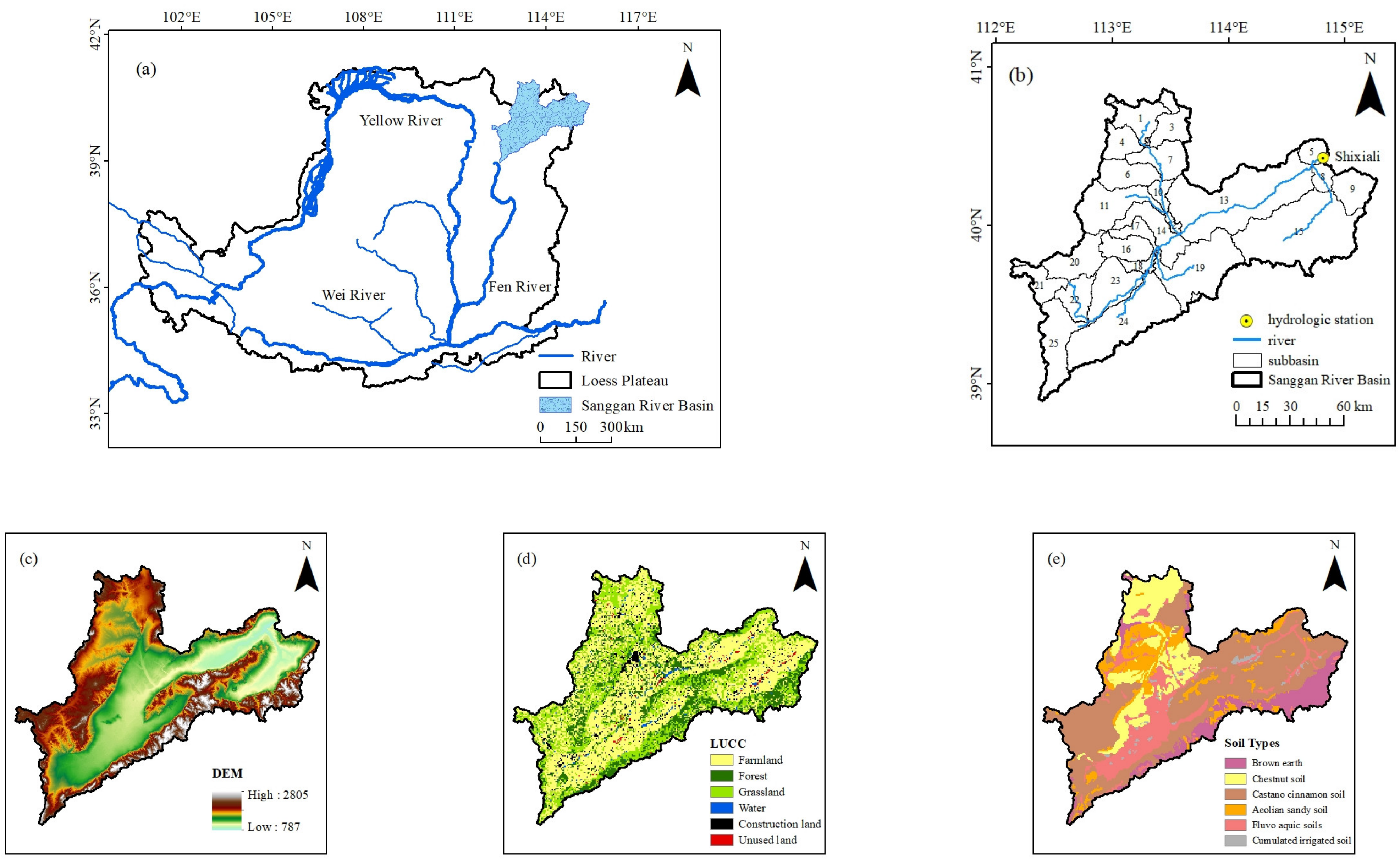


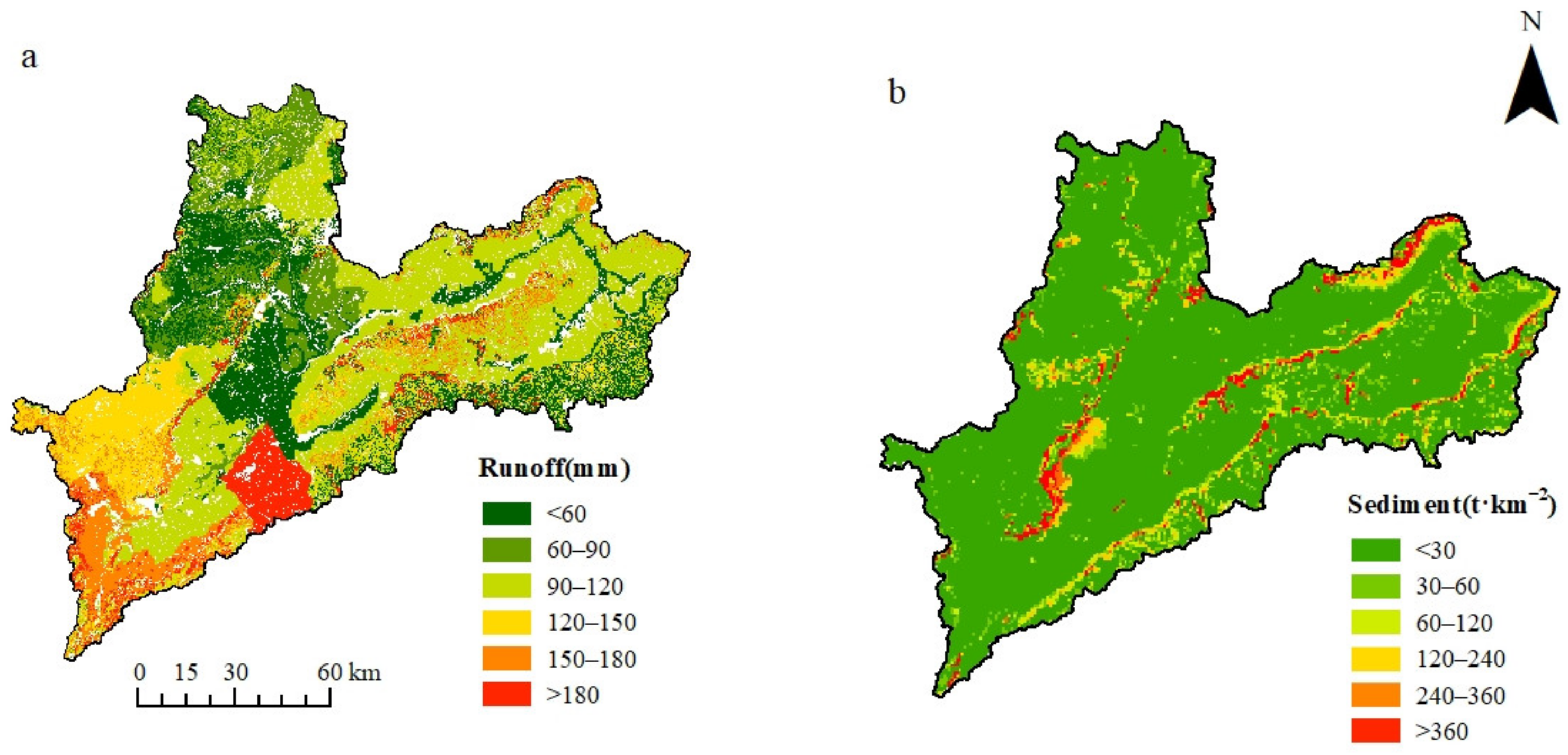
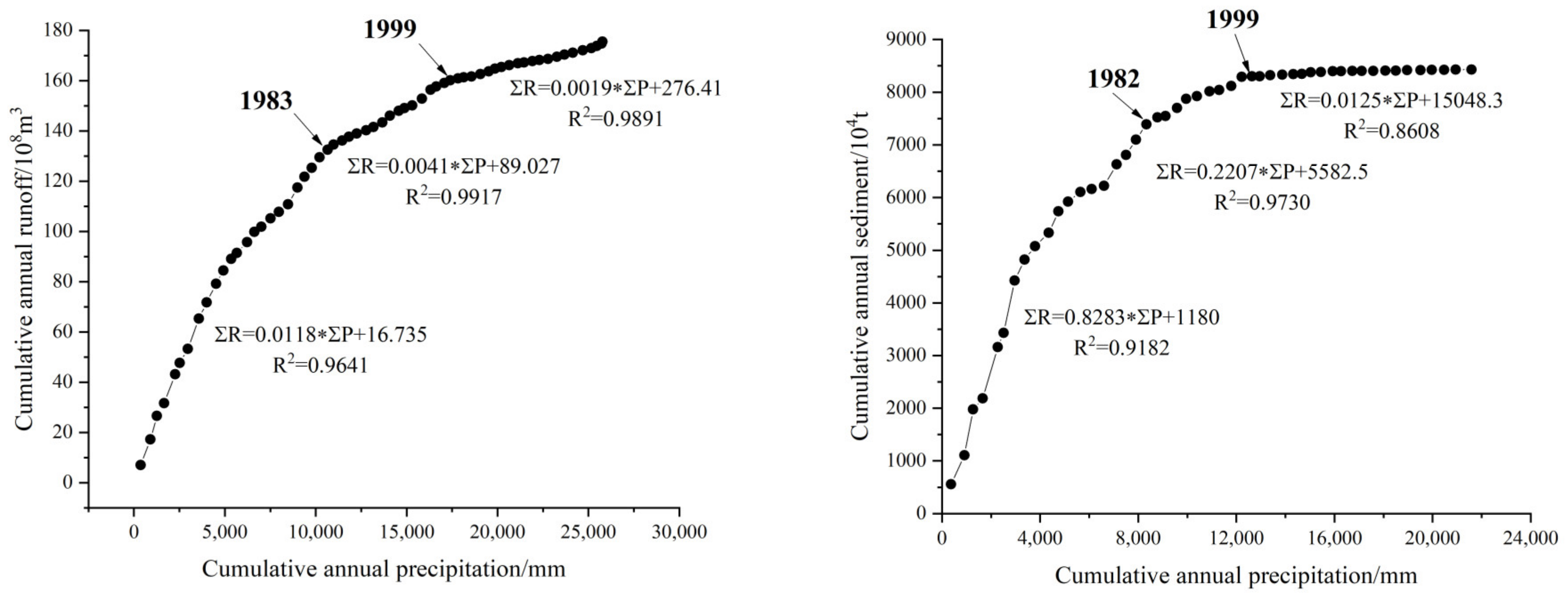

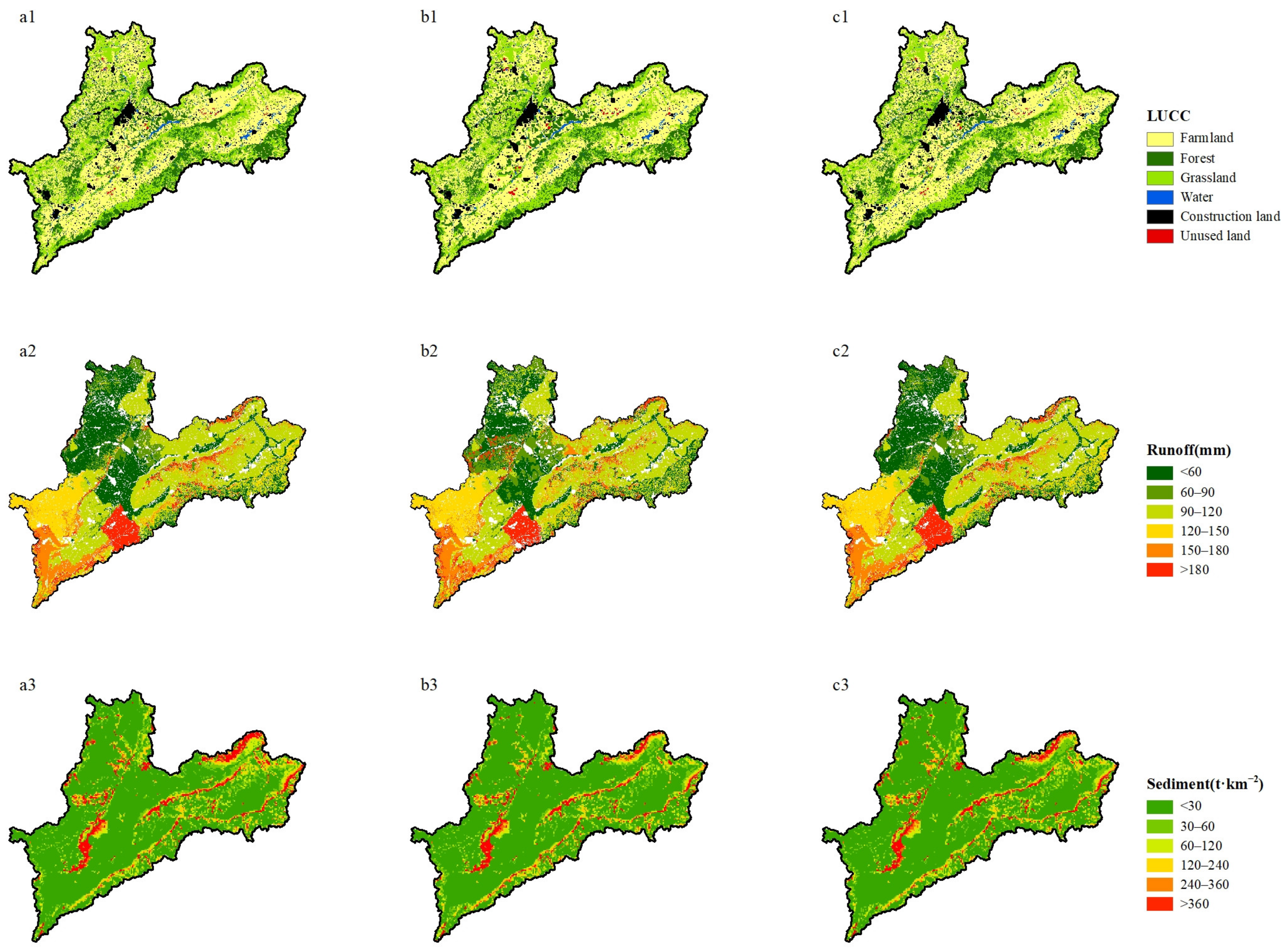
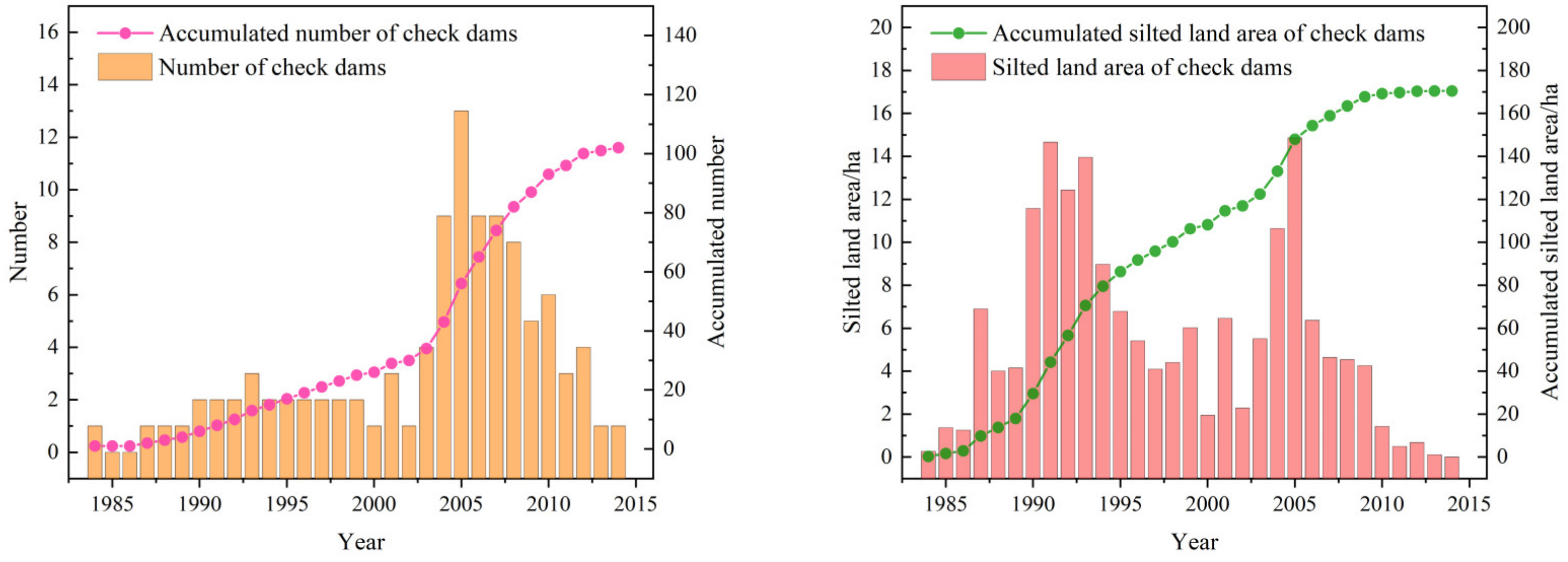

| Datasets | Information | Type | Resolution | Period | Sources |
|---|---|---|---|---|---|
| Meteorological data | The daily maximum temperature, minimum temperature, precipitation, wind speed, evaporation, relative humidity, and total radiation from 26 weather stations within and outside the Sanggan River Basin | Txt (for SWAT) | - | 1960–2020 | China Meteorological Science Data Center |
| Raster (for InVEST) | 90 m | ||||
| Streamflow and Sediment | Monthly streamflow and annual sediment data at Shixiali hydrological station | Text | - | 1960–2020 | Hydrological Yearbooks of Haihe Basin |
| DEM | SRTM (Shuttle Radar Topography Mission) data | Raster | 90 m | - | Geospatial Data Cloud |
| Land use/cover date | China remote sensing monitoring database | Raster | 90 m | 1990, 2000, 2010, and 2020 | Data Center for Resources and Environmental Sciences, CAS |
| Soil data | China soil database (1:100,000) | Raster | 90 m | - | Soil Information System of China |
| Check dam data | The number of check dams and the silted land area of check dams | Text | - | 1984–2014 | Shanxi Water Resources Bulletin |
| Water consumption data | Industrial, agricultural, urban, and total water consumption in the Sanggan River Basin. | Text | - | 1984–2020 | Shanxi Water Resources Bulletin |
| Periods | ΔQclime | ΔQlucc | ΔQtotal |
|---|---|---|---|
| P0–P1 | Qclime1+lucc0 − Qclime0+lucc0 | Qclime1+lucc1 − Qclime1+lucc0 | Obs1 − Obs0 |
| P0–P2 | Qclime2+lucc0 − Qclime0+lucc0 | Qclime2+lucc2 − Qclime2+lucc0 | Obs2 − Obs0 |
| Land-Use Types | Farmland | Forest | Grassland | Water | Construction Land | Unused Land |
|---|---|---|---|---|---|---|
| C | 0.08 | 0.003 | 0.04 | 0 | 0.001 | 1 |
| P | 1 | 1 | 1 | 0 | 0.001 | 1 |
| Hydrological Elements | Period | Climate Change | Human Intervention | ΔQtotal | ||
|---|---|---|---|---|---|---|
| ΔQclime | Contribution (%) | ΔQhuman | Contribution (%) | |||
| streamflow/108 m3 | P0–P1 | −0.5667 | 15.007 | −3.2098 | 84.993 | −3.7765 |
| P0–P2 | −0.2251 | 4.726 | −4.5383 | 95.274 | −4.7635 | |
| sediment/104 t | P0–P1 | −37.503 | 13.623 | −237.782 | 86.377 | −275.284 |
| P0–P2 | −24.997 | 6.443 | −362.977 | 93.557 | −387.973 | |
| Hydrological Elements | Period | Climate Change | LUCC | Other Human Interventions | ΔQtotal | |||
|---|---|---|---|---|---|---|---|---|
| ΔQclime | Contribution (%) | ΔQlucc | Contribution (%) | ΔQhuman | Contribution (%) | |||
| streamflow/108 m3 | P0–P1 | −0.5758 | 15.247 | 0.0011 | −0.03 | −3.2018 | 84.783 | −3.7765 |
| P0–P2 | −0.4363 | 9.160 | −0.0101 | 0.211 | −4.3171 | 90.629 | −4.7635 | |
| sediment/104 t | P0–P1 | −53.9592 | 19.601 | 3.7132 | −1.349 | −225.038 | 81.748 | −275.284 |
| P0–P2 | −35.4158 | 9.128 | −11.8457 | 3.053 | −340.7115 | 87.818 | −387.973 | |
| Land-Use Types | Area/103 km2 | ||||
|---|---|---|---|---|---|
| 1990 | 2020 | Natural Development Scenario in 2030 | Ecological Protection Scenario in 2030 | Urban Expansion Scenario in 2030 | |
| Farmland | 11.50 | 11.07 | 10.5 | 10.49 | 10.47 |
| Forest | 3.65 | 3.77 | 3.87 | 3.89 | 3.87 |
| Grassland | 7.31 | 7.29 | 7.49 | 7.49 | 7.48 |
| Water | 0.46 | 0.40 | 0.48 | 0.49 | 0.48 |
| Construction land | 0.8 | 1.13 | 1.38 | 1.36 | 1.42 |
| Unused land | 0.18 | 0.24 | 0.18 | 0.18 | 0.18 |
Disclaimer/Publisher’s Note: The statements, opinions and data contained in all publications are solely those of the individual author(s) and contributor(s) and not of MDPI and/or the editor(s). MDPI and/or the editor(s) disclaim responsibility for any injury to people or property resulting from any ideas, methods, instructions or products referred to in the content. |
© 2024 by the authors. Licensee MDPI, Basel, Switzerland. This article is an open access article distributed under the terms and conditions of the Creative Commons Attribution (CC BY) license (https://creativecommons.org/licenses/by/4.0/).
Share and Cite
Wang, J.; Li, M.; Li, X.; Wang, S.; Li, Q.; Li, Y.; Zhang, L. Response Study of Streamflow and Sediment Reduction in the Northeast Region of the Loess Plateau under Changing Environment. Sustainability 2024, 16, 1475. https://doi.org/10.3390/su16041475
Wang J, Li M, Li X, Wang S, Li Q, Li Y, Zhang L. Response Study of Streamflow and Sediment Reduction in the Northeast Region of the Loess Plateau under Changing Environment. Sustainability. 2024; 16(4):1475. https://doi.org/10.3390/su16041475
Chicago/Turabian StyleWang, Jinfeng, Min Li, Xiujuan Li, Sheng Wang, Qing Li, Ya Li, and Lixing Zhang. 2024. "Response Study of Streamflow and Sediment Reduction in the Northeast Region of the Loess Plateau under Changing Environment" Sustainability 16, no. 4: 1475. https://doi.org/10.3390/su16041475
APA StyleWang, J., Li, M., Li, X., Wang, S., Li, Q., Li, Y., & Zhang, L. (2024). Response Study of Streamflow and Sediment Reduction in the Northeast Region of the Loess Plateau under Changing Environment. Sustainability, 16(4), 1475. https://doi.org/10.3390/su16041475






